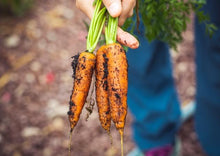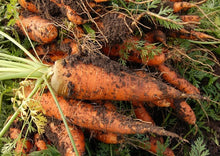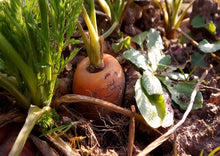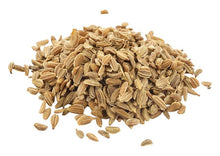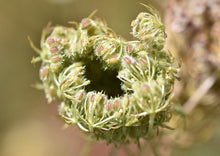
The origin of the Sweet Asian Kuroda Carrot can be traced back to Japan, where it was traditionally grown by farmers for its unique taste and high yield. It is also known as "Kuroda" carrot, named after a Japanese farmer who developed this variety. It has been gaining popularity in recent years among home gardeners and farmers alike for its sweet taste and high yield.
Kuroda carrots are sugary sweet and the texture is ultra-fine grained. They are renowned for their flavor, texture, and sweetness.
Heirloom Organically Grown Sweet Asian Kuroda Carrots are a unique and rare variety of carrot that is prized for its sweet, rich flavor and high yield. The Kuroda Carrot is considered an heirloom variety because it is open-pollinated, meaning it is not genetically modified or hybridized. Additionally, these seeds are certified organic, which means they are grown without the use of synthetic pesticides or fertilizers, ensuring a high-quality, safe and healthy crop.
This heirloom variety is perfect for those looking to add a touch of flavor to their gardens and farms. These carrots are great for juicing or eating fresh and are a great addition to any meal. They are also known for their higher Beta-carotene and sugar content.
Kuroda Carrots performs exceptionally well in warmer climates, where growing traditional varieties may be difficult. While they can be overwintered, they perform well when grown in spring as temperatures are warming. Because they are a chantenay-type, they also are great for hard clay or rocky soils.
Growing
Carrots grown in garden are full of flavor and texture. They are easy to grow as long as they are planted in loose, sandy soil during the cooler periods of the growing season—spring and fall (carrots can tolerate frost). Depending on the variety and local growing conditions, carrots may take anywhere from 2 to 4 months to mature. Plant them in the spring and summer for a continuous harvest through fall!
Planting
- Proper soil preparation is extremely important for carrot growing. If the carrot roots can’t easily grow unobstructed, it can lead to stunted and misshapen crops. Till down 12 inches and make sure there are no rocks, stones, or even soil clumps that could impede your carrots’ growth.
- Sow seeds outdoors 3 to 5 weeks before the last spring frost date. For continuous harvest, sow seeds every 2 weeks through late spring. For a fall harvest, sow seeds in mid- to late summer—starting about 10 weeks before your first fall frost.
- Sow seeds directly in the garden rather than transplanting. Carrots do not like to have their roots disturbed.
- Keep the soil moist with frequent shallow watering. For small carrot seeds to germinate, the soil shouldn’t form a hard crust on top; cover with a layer of vermiculite or fine compost to prevent a crust from forming.
- Avoid amending the soil with nitrogen-rich fertilizer, which causes carrots to fork and grow little roots.
- If the ground has clay, consider planting in a raised bed at least 12 inches deep and filled with airy, loamy soil.
- Choose a location that receives full sunlight. Carrot plants can tolerate partial shade too.
- Soil must be loose, sandy or loamy, and airy so that carrot roots can easily push down through the soil.
Care
- When seedlings are an inch tall, thin so that they stand 3 to 4 inches apart. Snip tops with scissors instead of pulling them out to prevent damage to the fragile roots of the remaining plants.
- Gently mulch carrots to retain moisture, speed germination, and block the sun from hitting the roots directly.
- Water at least one inch (about ½ gallon per square foot) per week to start, then two inches as roots mature.
- Weed diligently, but be careful not to disturb the young carrots’ roots while doing so.
Pests / Diseases
- Pests: Black canker, Carrot rust flies, Flea Beetles, Root-knot nematodes, Wireworms
- Aster Yellow Disease will cause shortened and discolored carrot tops and hairy roots. This disease is spread by pests as they feed from plant to plant. Keep weeds down and invest in a control plan for pests such as leafhoppers. This disease has the ability to overwinter.








